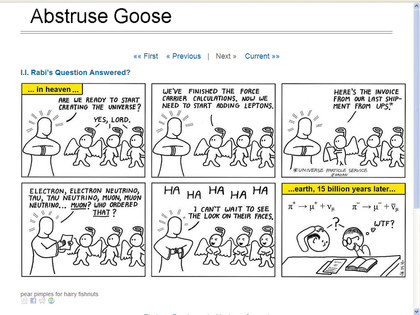
Rebecca Clements, an Australian illustrator, wasn't expecting much when she put her first comic online. "I thought I'd just start a web comic with no expectations at all to see where it went. And that's that," she says.
But her quirky comic Kinokofry, which features a cast of wisecracking mushrooms, has become a phenomenon online – and it's not the only one. An increasing number of artists are turning to the internet to express their ideas, find an audience and, in some cases, to make a living.
With no editors, publishers, or advertisers to upset, online cartoonists are free to explore uncomfortable issues and ask difficult questions of society, making the world of online cartoonists about as far away from Mickey Mouse as it's possible to get.
"I'd always played with the idea of writing an occasional comic strip," says Edinburgh based cartoonist and programmer Matt Gemmell, who draws the Sheercore comic in his spare time. "The web lets me do that and share the results with people without cost or commitment, so it becomes a leisure activity rather than a hassle."
"We are our own bosses. The only people censoring us is ourselves," agrees Matt Melvin. Together with his friends, Rob and Dave, Matt draws the online cartoon series Cyanide and Happiness. Like other online cartoonists, art has been a lifelong passion for Matt.
"Like most kids, we all drew all over our notebooks and papers in school. We just never stopped. Luckily, the artistic skill required hasn't changed much," he says.
"We've sort of got our different styles, but overall we go for complete simplicity," adds fellow Cyanide and Happiness cartoonist Rob Denbleyker. "Stick figures whose only difference is the colour of their shirt, set against white backgrounds. Occasionally there will be a background or prop if the joke demands it."
Sign up for breaking news, reviews, opinion, top tech deals, and more.
Stylish work
There are, it seems, as many styles of online cartoon as there are people drawing them. "Kinokofry is fun, a bit strange, fantastical, cute," says Clements. "I would hope it's seen as imaginative. Full of things to keep the eye wandering all over the page."
Of those we spoke to, the artist who sticks closest to the style of the traditional comic strip is Jeph Jacques, who draws Questionable Content. How would he describe his style? "Improving!" he says modestly.
"I don't know if I have any particular style, but the word 'minimalist' comes to mind," says the man behind the Abstruse Goose comic site, who wished to be known simply as 'that guy who draws Abstruse Goose'. So be it.

GETTING NOTICED: Word of mouth and social media sites are the secret to Abstruse Goose's success
"I often only draw the minimum necessary to convey my idea," he says. "If you read through my archives, you'll see that many of my comics feature disembodied heads with very little detail. In some ways, this is how human perception works. The brain focuses attention on salient features of the environment and discards extraneous noise."
Ryan North is the man behind Dinosaur Comics. He's used the same six-panel strip since 2003 and simply fits each new story onto it. "What do I do? In a sentence: I use the same pictures of dinosaurs every day but think up of new things for them to say. It's better than it sounds. OK, that's two sentences; but I feel the latter one is important."